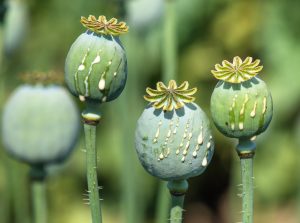Myanmar has overtaken Afghanistan as the world’s top producer of opium after the third consecutive year of expanding cultivation, the United Nations said in a new report, attributing the increase to the country’s intensifying conflict.
In its annual Southeast Asia Opium Survey, released yesterday, the U.N. Office on Drugs and Crime (UNODC) reported that the area of opium poppy under cultivation in Myanmar increased by 18 percent over the past year, from 40,100 hectares last year to 47,100 hectares in 2023. The figure was 30,200 hectares in 2021.
The report attributed this increase to the chaos and conflict that have followed the military’s takeover in February 2021. The subsequent “economic, security, and governance disruptions… continue to drive farmers in remote areas towards opium to make a living,” UNODC Regional Representative Jeremy Douglas said in a statement accompanying the report’s release.
Douglas added that the recent intensification of conflict in Shan State, where resistance forces have launched a broad offensive against the Myanmar military and its allies, “is expected to accelerate this trend.” At the same time, instability, insecurity, economic turbulence has only increased the attractiveness of opium cultivation for smallholders who earn a living from the land.
This expansion of opium cultivation in Myanmar took place at the same time that Afghanistan, after more than two decades as the world’s leading supplier of opium, saw its cultivated area plummet from 233,000 hectares in 2022 to under 11,000 this year, owing to the ruling Taliban’s strict enforcement of a ban on poppy farming. Although poppy cultivation levels remain below their historic peak of 58,000 tons, recorded in 2013, Myanmar now stands as the world’s largest source of opium.
The UNODC report said that in addition to expanding cultivation, poppy farming in Myanmar, traditionally the preserve of smallholders using rudimentary techniques, “continues to become more sophisticated and productive.” The estimated opium yield expanded by 16 per cent to 22.9 kilograms per hectare this year, the highest opium production estimate since 2001.
The report said that this was likely due to increasingly sophisticated means of cultivation, including increased plot densities, improved organization of plants, and the use of fertilizers and irrigation systems. At the same time, as conflict expands, more and more farmers are cultivating opium in order to make ends meet.
The UNODC’s latest Southeast Asia Opium Survey once again points to the ramifying and pernicious impacts of the Myanmar military’s February 2021 coup d’etat. In addition to inflaming conflict across the country – an estimated 2.5 million people, not far shy of 5 percent of the country’s population, are now internally displaced, according to the U.N. – the military’s seizure of power has devastated the country’s economy.
In its semiannual Myanmar Economic Monitor, also released yesterday, the World Bank projected the country’s economy to grow by just 1 percent over the fiscal year to March 2024, due to high inflation, the precipitous decline in the value of the kyat, and disruptions to trade due to the fighting in Shan State. It reported that Myanmar is the only one in East Asia whose economy has not returned to pre-pandemic levels, and remains about 10 percent smaller than it was in 2019.
“The economic situation has deteriorated, and uncertainty about the future is increasing,” World Bank Country Director for Myanmar Mariam Sherman told Nikkei Asia. “High food price inflation has had a particularly severe impact on the poor, who spend a larger portion of their income on food and who tend to live in areas where prices have risen at a faster pace.”
The shrinkage of the formal economy has been paralleled by a growth in the illicit industries that have long flourished on the country’s periphery, particularly in autonomous areas like Shan State that are under the control of ethnic rebel groups and military-aligned militias. Back in June, in its annual report on the Asian synthetic drug market, the UNODC documented how the post-coup chaos had contributed to a boom in methamphetamine production in eastern Myanmar. It noted that Asian anti-drug authorities seized 151 tons of methamphetamine in 2022. While this represented a drop on the 171.5 tons seized in 2021, it was nearly double the 82.5 tons seized in 2017.
Nearly three years after the coup, there appears no real end in sight for Myanmar’s booming drug production. Even as domestic factors continue to empower drug syndicates and incentivize opium cultivation in Shan State and other parts of Myanmar, the sharp reduction in the global production due to the crackdown in Afghanistan could further fuel the boom. By driving prices higher, the UNODC said, global shortages will “likely encourage more cultivation and production in Southeast Asia.”
































